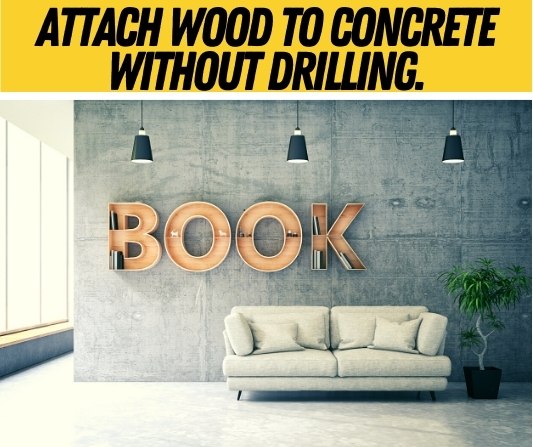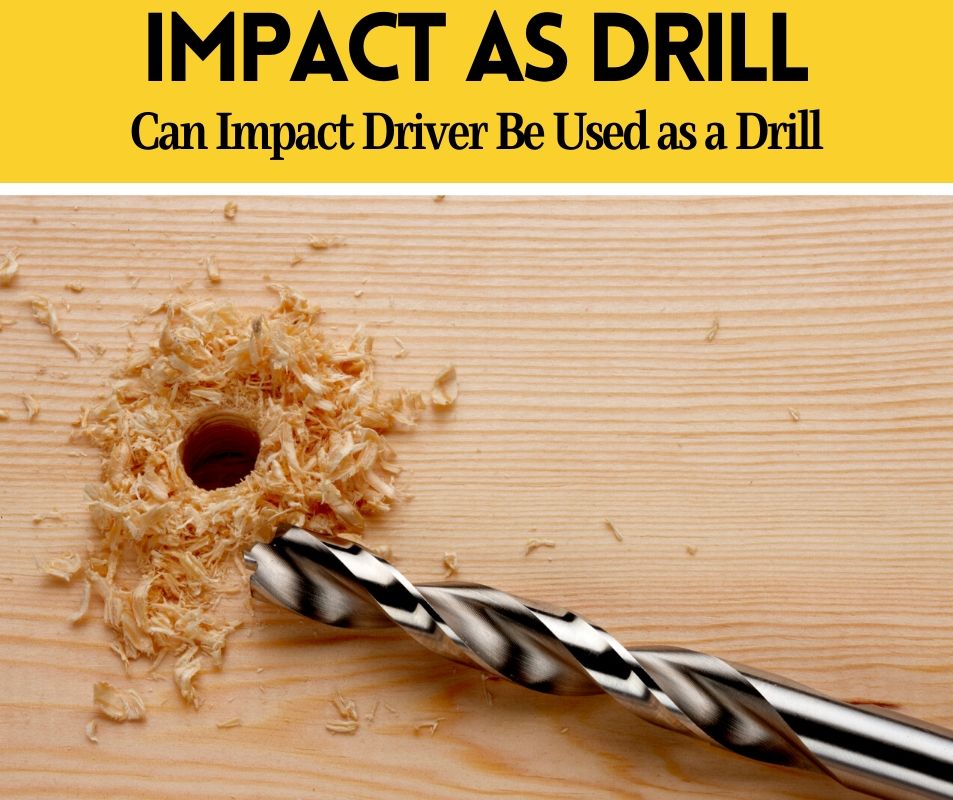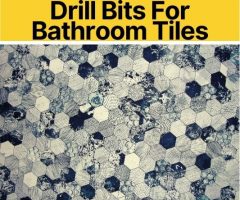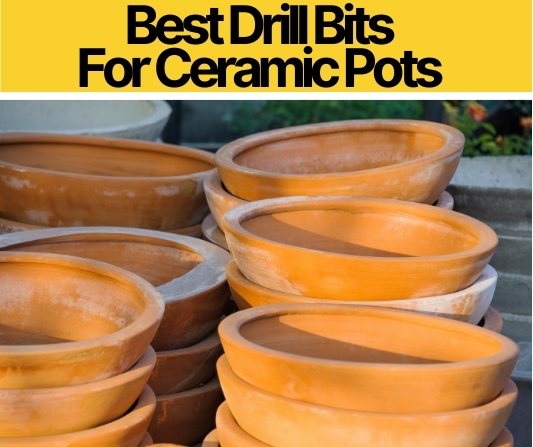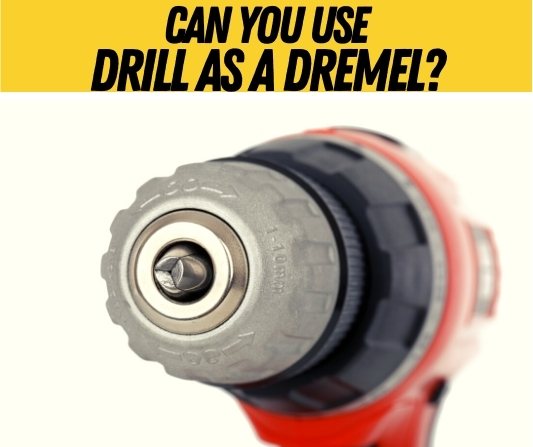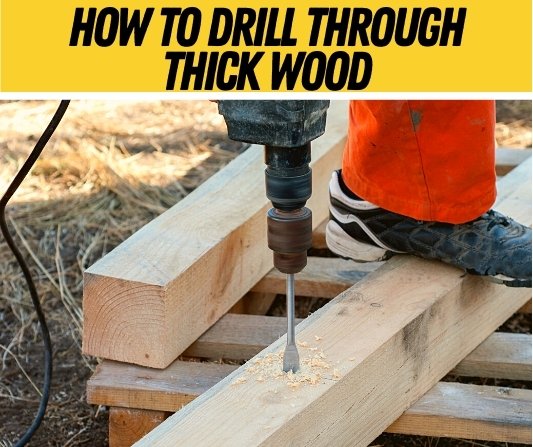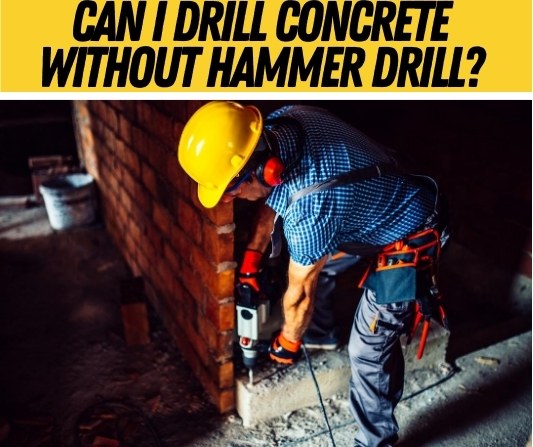 You might have a DIY project ahead of you which requires drilling into concrete, but you don’t have a hammer drill?
You might have a DIY project ahead of you which requires drilling into concrete, but you don’t have a hammer drill?
In this article, we’ll look at the details of how you can drill into concrete surfaces in your home without a hammer drill.
+What the limits of using a typical rotary drill on these tougher surfaces are.
Can I drill concrete without a hammer drill?
Most, but not all, concrete surfaces can be drilled into using a regular drill, as long as you use a good masonry bit and keep the tool and work surface cool. This isn’t as simple a question as it might first appear, because not all concrete is the same.
The major factor in how easy it is to drill into a material is its density, and concrete comes in a wide range of densities. Depending on the kind of concrete you’re dealing with, you may find that a standard drill is almost as effective as a hammer drill, or you may find that it’s completely useless. Most of the time, your experience will be somewhere in the middle.
Older concrete tends to be denser, as does concrete used in structures that need to bear heavy loads. A concrete foundation in a mid-20th-century house is probably made of dense enough material that a standard drill will have a lot of trouble cutting through it, and you’ll be more likely to damage your drill or your bit in the attempt.
On the other hand, most concrete you’ll find around a modern home present no problems for a standard rotary drill, if you use the right bit and the right technique. Concrete walls, countertops, and other cosmetic elements can be drilled with a good rotary drill and an appropriate masonry bit and a little patience.
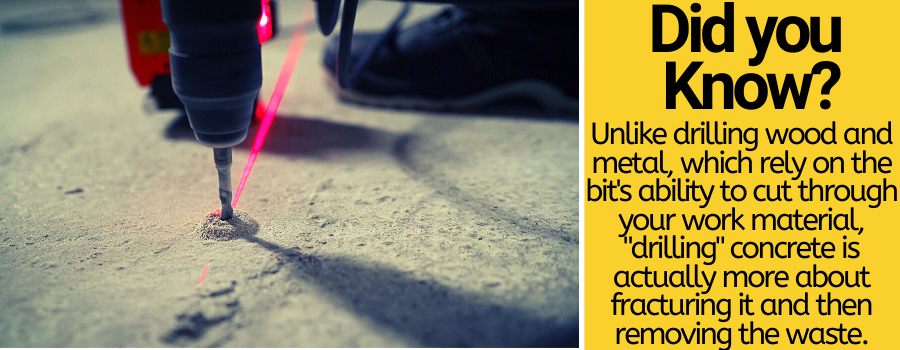
What are the best drill bits for drilling concrete without a hammer drill?
Use a carbide- or tungsten-carbide-coated bits to drill concrete. The best choices are bits specifically designed for working with concrete, which have very sharp tips and wide flutes designed to move waste material away quickly and avoid clogs.
You might not need a concrete-specific bit, however. If you have a multi-bit set laying around that you got when you first bought your drill, it’s possible it includes masonry bits, which are very similar. As long as the tip is nice and sharp, a standard masonry bit should cut through most concretes quite easily.
Using a regular drill for concrete
Once you’ve got the right bit, the key to using a regular drill on concrete is to go slowly and keep your drill bit and work surface cool. You’ll need to accept that this process will take a lot more time than drilling into softer materials like wood.
How to drill into concrete with a regular drill
The friction of a drill bit spinning against concrete creates a lot of heat, and the substantial dust generated in the process can trap that heat inside the hole you’re drilling. This heat can start to weaken the bit, which may dull or even snap as a result. Running your drill too fast for too long can also damage the drill motor itself. Overall, you’ll have fewer problems if you keep your drill on a lower speed setting.
If your drill bit starts to get too hot – a good measure for this is if it gets hot enough that touching the bit is painful – take a break to let it cool down. You can also try spraying some water on the concrete surface and the bit to help everything cool back down faster. Adding a bit of water to the hole being drilled can also keep some of the concrete dust out of the air, which is a benefit in its own right since concrete dust can be harmful to your health.
Unlike drilling wood and metal, which rely on the bit’s ability to cut through your work material, “drilling” concrete is actually more about fracturing it and then removing the waste. For that reason, you’ll need to apply plenty of pressure to the drill. This will help the bit impact the concrete with greater force, breaking off more of it with each rotation.
How effective it will be compared to hammer drill?
In the end, unless you’re working with a very hard concrete, a regular drill can produce just as deep and accurate a hole as a hammer drill, so you’ll have no trouble completing your project, whether it’s adding a faucet to a concrete countertop or hanging a painting on a concrete wall. However, there’s no getting around the fact that hammer drills get through this process much, much faster – it’s simply a matter of their being specifically designed to handle this kind of task. A hammer drill can drill an inch-deep hole through concrete in less than a minute, while you may spend half an hour or longer on the task with a regular rotary drill and not a suitable drill bit. If your project requires drilling more than a couple of holes in a concrete surface, you may be better off renting a hammer drill for the afternoon.
Tips for drilling into various concrete types
You’ll find different types of concrete in different places around your home. Here are some tips on working with a few common sorts:
Concrete walls
Concrete walls are generally a fairly easy surface to drill into, comparatively speaking. Most are made of a fine, light concrete that will cut easily with a good masonry bit. Because you’re working with a vertical surface, you might find the drill bit has a tendency to slip; try drilling a shallow pilot hole with a smaller bit first, to give the larger bit something to sit in as it gets started.
Concrete blocks
Concrete blocks tend to be made of coarser grained concrete, but they’re still fairly light. You may have more trouble keeping the hole circular as larger pieces of concrete break off – if you’ve ever seen how easily a cinder block can break into pieces when it’s dropped at just the right angle, you’ll have an idea of how this works. The best strategy to avoid this is to drill a full-depth pilot hole with a small diameter bit, then follow up with a larger one.
Concrete floors
Concrete floors present a more difficult task. They’re built for heavy wear, and second only to structural elements like concrete pillars and foundations in density and hardness. Make sure you’re using a high-quality bit, keep your tool and work surface cool, and maintain strong, consistent downward pressure on the drill.
How to screw into concrete without a hammer drill
There are lots of reasons you might want to screw into concrete – maybe you’re hanging a shelf or a piece of art on a concrete feature wall in your living room, or trying to attach a gutter downpipe to a concrete surface on the outside of your home. In general, the procedure is similar to the best practices for screwing into drywall: for light loads, the right kind of screw can be driven directly in the surface, while heavier loads require drilling a clean hole and then inserting the right sort of anchor.
Can I screw directly into concrete?
For lighter loads – generally up to a few kilograms – you can forego using screw anchors and screw directly into concrete, provided you use proper concrete screws. Concrete screws have a unique, non-uniform thread with different spirals and heights along the length of the screw; this helps them bite into materials which would tend to come apart under the force of having a wood screw, with its larger uniform threads, driven into them.
For heavier loads, it’s better to use an anchor. If you have a hollow concrete wall, a toggle wing anchor will work best – these have two spring-loaded wings that expand once pushed through the concrete into the hollow space. In solid concrete, wedge anchors are generally the strongest type – these have a metal sleeve that expands as a screw is driven into the anchor, pressing against the concrete surface on all sides.
Using concrete screws without hammer drill
The first step in using any kind of concrete screw or anchor is drilling a pilot hole, which – as described earlier in this article – can often be done without a hammer drill or other specialized tools, unless you’re dealing with a particularly dense kind of concrete. If you’re using a concrete screw without an anchor, drill a pilot hole a little smaller than the screw diameter, and then insert the screw itself. An impact driver will be helpful, but not absolutely necessary, in getting the screw in. If you’re using an anchor, you’ll need to drill a larger hole, big enough for the anchor to be inserted. This is usually still possible without a hammer drill, but as the hole you need to make gets larger, the benefits of a more powerful tool do become more significant.
Do you need a hammer drill for Tapcon screws?
The manufacturers of Tapcon screws recommend using a hammer drill to make pilot holes and drive the screw itself, but it’s not strictly necessary in most instances. If you find your regular rotary tool is able to drill the pilot hole but not to drive the screw into it, you may find that an impact driver will do the job.
Do I need to drill a pilot hole for concrete screws?
Pilot holes are essential for concrete screws, though they should be thought of a little differently from those used in screwing into wood. It’s not just the need to remove extra material to prevent it from being trapped behind the inserted screw that creates the need for a pilot hole in concrete; it’s also the fact that while concrete screws are sharp, they lack the force of a masonry bit and can’t cut through concrete on their own. When working with concrete screws, drill a pilot hole that is at least the full depth of the screw, but 1-1.5mm (1/32-1/16″) smaller in diameter.

